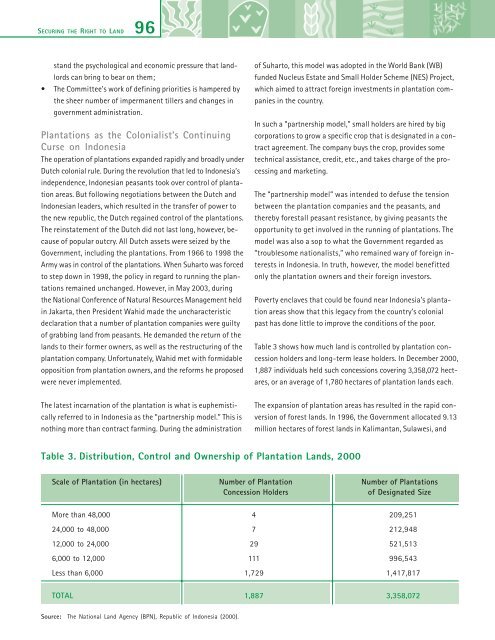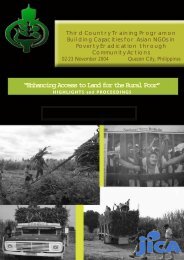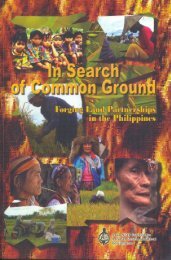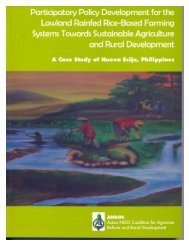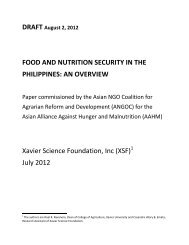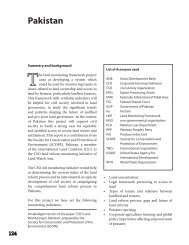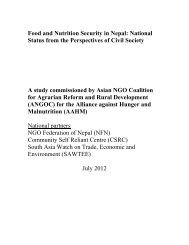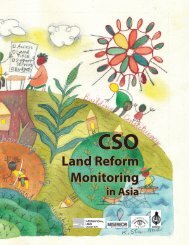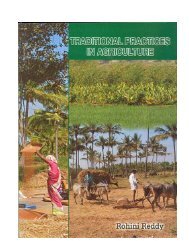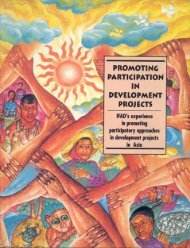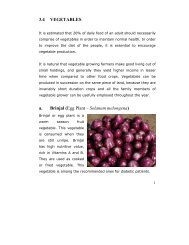Securing the Right to Land FULL - ANGOC
Securing the Right to Land FULL - ANGOC
Securing the Right to Land FULL - ANGOC
You also want an ePaper? Increase the reach of your titles
YUMPU automatically turns print PDFs into web optimized ePapers that Google loves.
SECURING THE RIGHT TO LAND<br />
96<br />
stand <strong>the</strong> psychological and economic pressure that landlords<br />
can bring <strong>to</strong> bear on <strong>the</strong>m;<br />
The Committee’s work of defining priorities is hampered by<br />
<strong>the</strong> sheer number of impermanent tillers and changes in<br />
government administration.<br />
Plantations as <strong>the</strong> Colonialist’s Continuing<br />
Curse on Indonesia<br />
The operation of plantations expanded rapidly and broadly under<br />
Dutch colonial rule. During <strong>the</strong> revolution that led <strong>to</strong> Indonesia’s<br />
independence, Indonesian peasants <strong>to</strong>ok over control of plantation<br />
areas. But following negotiations between <strong>the</strong> Dutch and<br />
Indonesian leaders, which resulted in <strong>the</strong> transfer of power <strong>to</strong><br />
<strong>the</strong> new republic, <strong>the</strong> Dutch regained control of <strong>the</strong> plantations.<br />
The reinstatement of <strong>the</strong> Dutch did not last long, however, because<br />
of popular outcry. All Dutch assets were seized by <strong>the</strong><br />
Government, including <strong>the</strong> plantations. From 1966 <strong>to</strong> 1998 <strong>the</strong><br />
Army was in control of <strong>the</strong> plantations. When Suhar<strong>to</strong> was forced<br />
<strong>to</strong> step down in 1998, <strong>the</strong> policy in regard <strong>to</strong> running <strong>the</strong> plantations<br />
remained unchanged. However, in May 2003, during<br />
<strong>the</strong> National Conference of Natural Resources Management held<br />
in Jakarta, <strong>the</strong>n President Wahid made <strong>the</strong> uncharacteristic<br />
declaration that a number of plantation companies were guilty<br />
of grabbing land from peasants. He demanded <strong>the</strong> return of <strong>the</strong><br />
lands <strong>to</strong> <strong>the</strong>ir former owners, as well as <strong>the</strong> restructuring of <strong>the</strong><br />
plantation company. Unfortunately, Wahid met with formidable<br />
opposition from plantation owners, and <strong>the</strong> reforms he proposed<br />
were never implemented.<br />
The latest incarnation of <strong>the</strong> plantation is what is euphemistically<br />
referred <strong>to</strong> in Indonesia as <strong>the</strong> “partnership model.” This is<br />
nothing more than contract farming. During <strong>the</strong> administration<br />
Table 3. Distribution, Control and Ownership of Plantation <strong>Land</strong>s, 2000<br />
Scale of Plantation (in hectares) Number of Plantation Number of Plantations<br />
Concession Holders of Designated Size<br />
More than 48,000 4 209,251<br />
24,000 <strong>to</strong> 48,000 7 212,948<br />
12,000 <strong>to</strong> 24,000 29 521,513<br />
6,000 <strong>to</strong> 12,000 111 996,543<br />
Less than 6,000 1,729 1,417,817<br />
TOTAL 1,887 3,358,072<br />
Source: The National <strong>Land</strong> Agency (BPN), Republic of Indonesia (2000).<br />
of Suhar<strong>to</strong>, this model was adopted in <strong>the</strong> World Bank (WB)<br />
funded Nucleus Estate and Small Holder Scheme (NES) Project,<br />
which aimed <strong>to</strong> attract foreign investments in plantation companies<br />
in <strong>the</strong> country.<br />
In such a “partnership model,” small holders are hired by big<br />
corporations <strong>to</strong> grow a specific crop that is designated in a contract<br />
agreement. The company buys <strong>the</strong> crop, provides some<br />
technical assistance, credit, etc., and takes charge of <strong>the</strong> processing<br />
and marketing.<br />
The “partnership model” was intended <strong>to</strong> defuse <strong>the</strong> tension<br />
between <strong>the</strong> plantation companies and <strong>the</strong> peasants, and<br />
<strong>the</strong>reby forestall peasant resistance, by giving peasants <strong>the</strong><br />
opportunity <strong>to</strong> get involved in <strong>the</strong> running of plantations. The<br />
model was also a sop <strong>to</strong> what <strong>the</strong> Government regarded as<br />
“troublesome nationalists,” who remained wary of foreign interests<br />
in Indonesia. In truth, however, <strong>the</strong> model benefitted<br />
only <strong>the</strong> plantation owners and <strong>the</strong>ir foreign inves<strong>to</strong>rs.<br />
Poverty enclaves that could be found near Indonesia’s plantation<br />
areas show that this legacy from <strong>the</strong> country’s colonial<br />
past has done little <strong>to</strong> improve <strong>the</strong> conditions of <strong>the</strong> poor.<br />
Table 3 shows how much land is controlled by plantation concession<br />
holders and long-term lease holders. In December 2000,<br />
1,887 individuals held such concessions covering 3,358,072 hectares,<br />
or an average of 1,780 hectares of plantation lands each.<br />
The expansion of plantation areas has resulted in <strong>the</strong> rapid conversion<br />
of forest lands. In 1996, <strong>the</strong> Government allocated 9.13<br />
million hectares of forest lands in Kalimantan, Sulawesi, and


